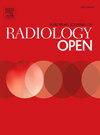A comprehensive model combining radiomics and risk factors for predicting massive hemorrhage in cesarean scar pregnancy during dilatation and curettage
IF 2.9
Q3 RADIOLOGY, NUCLEAR MEDICINE & MEDICAL IMAGING
引用次数: 0
Abstract
Background
To develop a comprehensive model integrating MRI radiomics signatures and independent risk factors for predicting the risk of massive bleeding during dilatation and curettage(D&C) in patients with cesarean scar pregnancy (CSP).
Methods
CSP patients who underwent D&C were retrospectively reviewed. Intraoperative massive bleeding was defined as bleeding exceeding 200 ml based on surgical records. Three-dimensional MRI T2-weighted images were obtained, and radiomics signatures were extracted from the gestational sac (GS). Subjects were randomly separated into the training and testing sets in a 7:3 ratio. Radiomics features and clinical variables were analyzed to conduct both radiomics and clinical models. The nomogram was established by combining Radscore and the selected clinical variables.
Results
Among 109 CSP patients, 33 patients experienced massive hemorrhage while 76 patients did not. Serum β-hCG and the maximum inlet diameter of the CSD (P < 0.05) were identified as significant clinical prognostic factors for massive hemorrhage. The nomogram demonstrated superior AUCs of 0.962 (95 % CI 0.928–0.989) and 0.926 (95 % CI 0.843–0.987) in the training and testing cohorts, respectively, Delong’s test was employed to compare the AUCs of the nomogram with those of the radiomics model and the clinical model. The results showed no significant differences between the nomogram and the other models in both the training (p > 0.05) and testing cohorts (p > 0.05). The nomogram calibration curve exhibited good agreement, with no significant differences found in the Hosmer-Lemeshow test (all p > 0.05). DCA revealed a substantial overall net benefit for the nomogram.
Conclusions
Our study achieved accurate prediction of massive hemorrhage during D&C in CSP patients by integrating MRI radiomics and clinical features, underscoring the synergistic effectiveness of radiomics combined with clinical variables. The combined nomogram offered valuable support for precise preoperative risk assessment and individualized treatment decisions.
结合放射组学和危险因素预测剖宫产瘢痕妊娠扩张期大出血的综合模型
目的:建立一个综合MRI放射组学特征和独立危险因素的综合模型,用于预测剖宫产瘢痕妊娠(CSP)患者扩张和刮宫(D&;C)期间大出血的风险。方法对行D&;C的scsp患者进行回顾性分析。术中大出血定义为根据手术记录出血超过200 ml。获得三维MRI t2加权图像,并从妊娠囊(GS)提取放射组学特征。受试者按7:3的比例随机分为训练组和测试组。分析放射组学特征和临床变量,同时进行放射组学和临床模型。结合Radscore和所选临床变量建立nomogram。结果109例CSP患者中33例发生大出血,76例未发生大出血。血清β-hCG和CSD最大入口直径(P <; 0.05)被认为是大出血的重要临床预后因素。训练组和测试组的nomogram auc分别为0.962(95 % CI 0.928-0.989)和0.926(95 % CI 0.843-0.987),采用Delong检验将nomogram auc与放射组学模型和临床模型auc进行比较。结果显示nomogram与其他模型在训练组(p >; 0.05)和检验组(p >; 0.05)上均无显著差异。nomogram校准曲线一致性较好,Hosmer-Lemeshow检验无显著差异(p均为 >; 0.05)。DCA显示了nomogram总体净收益。结论我们的研究将MRI放射组学与临床特征相结合,实现了对CSP患者D&;C期间大出血的准确预测,强调了放射组学与临床变量相结合的协同效应。联合nomographic为精确的术前风险评估和个性化治疗决策提供了有价值的支持。
本文章由计算机程序翻译,如有差异,请以英文原文为准。
求助全文
约1分钟内获得全文
求助全文
来源期刊

European Journal of Radiology Open
Medicine-Radiology, Nuclear Medicine and Imaging
CiteScore
4.10
自引率
5.00%
发文量
55
审稿时长
51 days
 求助内容:
求助内容: 应助结果提醒方式:
应助结果提醒方式:


